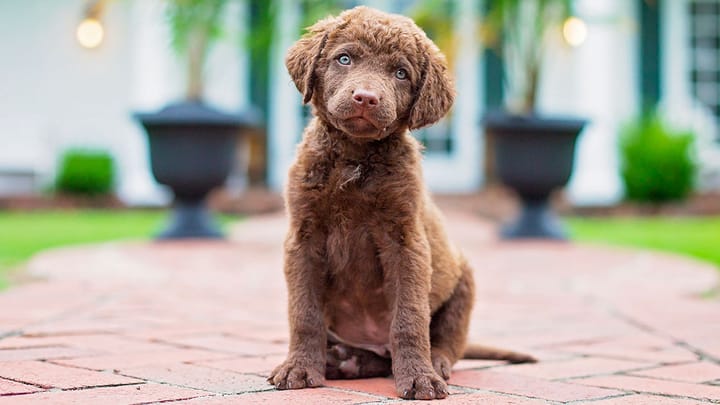Chesapeake Bay Retriever
Other names : Chessie, Bay, Chessy Dog


The Chesapeake Bay Retriever dog has a unique smile – when he is happy he will bare his teeth in a comical grin. This breed first originated as a water dog, used to hunt and retrieve ducks in the waters of Chesapeake Bay. He was ideal for this purpose because of his stamina, sturdy build and dense coat. Even today, he is still used for hunting purposes but is also a fine companion dog. Chesapeake Bays have webbed paws, making them fantastic swimming dogs.
|
Life expectancy |
The Chesapeake Bay Retriever has a life expectancy of between 10 and 12 years |
|
Temperament |
|
|
Size |
Medium
|
|
Adult size |
Female
Between 21 and 24 in
Male
Between 23 and 26 in
|
|
Adult weight |
Female
Between 55 and 71 lb
Male
Between 64 and 79 lb
|
|
Coat colour
Ash, Brown, Dark brown, Dead-grass, Light brown, Sedge. |
Brown Sand |
|
Type of coat
The Chesapeake Bay Retriever has a dense woolly undercoat, with a harsh, fine, oily topcoat. The dog has short wavy hair on his back, loins, shoulders and neck. |
Short |
|
Eye colour
Amber or yellowish. |
Brown
Green
|
Some Chesapeake Bay Retrievers are prone to suffer from ear infections and allergies. Ear infections can arise after a dog has been swimming in water for a lengthy period, so always ensure that the dog’s ears are dried thoroughly after swimming. The Chessie can also suffer from various allergies:
- Certain dog foodstuff that contains cereals or grains
- Airborne pollen
- Dust mites
- Chemicals in household cleaning products
- Tick and flea bites
More details about the Chesapeake Bay Retriever
Chesapeake Bay Retriever: Origins and history
The first Chesapeake Bay Retrievers were documented when 2 puppies were taken from a shipwreck some 200 years ago, off the Maryland coast. These pups loved being in water and looked similar to a Newfoundland breed. One of the rescued pups, a red dog, was named Sailor, while the other, a black bitch, was named Canton. Both dogs were bred with other breeds, producing the Chesapeake Bay we know today.
Physical characteristics of the Chesapeake Bay Retriever
With a classic retriever appearance, the Chesapeake Bay Retriever has a muscular body with a rounded head. It has a strong, wide chest and lean, long legs. The Chessie has webbed paws which allow him to swim really well.
FCI classification of the Chesapeake Bay Retriever
-
Group 8 - Retrievers - Flushing Dogs - Water Dogs
-
Section 1 : Retrievers
Chesapeake Bay Retriever: Characteristics
Chesapeake Bay Retriever: Behaviour
Training a Chesapeake Bay Retriever
So that any unwanted behaviours are held at bay, it’s important to begin training routines from a very young age. Chessies need to understand what their trainer is asking of them, otherwise they come across as quite stubborn.
Chesapeake Bay Retriever: Lifestyle
Breed compatibility Chesapeake Bay Retriever
Chesapeake Bay Retriever: Purchase price
You can expect to pay around £670 for KC Registered dogs and £570 for Non KC Registered Chesapeake Bay Retrievers. In addition, your monthly costs will amount to between £100 to £120 monthly, to account for food, veterinary bills, and pet insurance.
Chesapeake Bay Retriever: Shedding
Average
This breed sheds profusely and continually through the year, but perhaps more often during the spring and autumn.
Chesapeake Bay Retriever: Grooming
Regular brushing will keep the coat of the Chessie looking good. This also has the advantage of keeping loose hair from your furniture and clothes. The dog will also enjoy one or two baths during the year.
Chesapeake Bay Retriever: Health
The Chessie is generally a healthy breed, however as with many large working dogs, hip dysplasia and eye problems can appear. Their average life expectancy is 11 years.
This dog just loves to swim and can continue retrieving all day long if need be. He is an endurant, high energy hunting dog.
This breed much prefers a cooler climate, however providing he has opportunities to swim in warm weather, he will be fine.
The Chesapeake Bay Retriever loves being outdoors and around water. This dog was born to survive in the icy cold and choppy, rough waters of Chesapeake Bay in Maryland.
As with many other large dog breeds, when he retires from hunting duties, or has been neutered or spayed, he has a tendency to gain weight.
- Hip dysplasia
- Eye conditions
- Ear infections
- Allergies
Do you want a Chesapeake Bay Retriever dog ?
Oh no...
There are no Chesapeake Bay Retriever adoption profiles at the moment...







